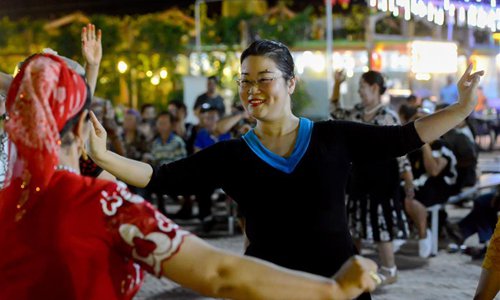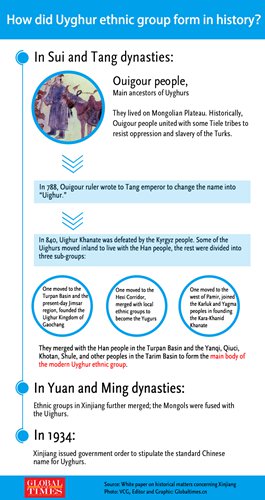HOME >> CHINA
White paper clarifies historical facts of Xinjiang
By Bai Yunyi and Liu Xin Source:Global Times Published: 2019/7/21 23:23:40
Uyghurs not descendants of Turks : white paper

Citizens and tourists dance at a night fair held in Turpan, northwest China's Xinjiang Uygur Autonomous Region, July 19, 2019. (Xinhua/Ding Lei)
The State Council Information Office released a white paper on Sunday to clarify historical issues about the Xinjiang Uyghur Autonomous Region, including that the Northwest China region has never been "East Turkistan" and Uyghurs are not descendants of the Turks, two false ideas promoted and distorted by separatist groups and some Western media.
Chinese experts said that important historical facts on Xinjiang are matters of principle. Clarifying the history of ethnic groups, culture and religions in the region is important to unifying different ethnic groups, maintaining stability and development.
The white paper "Historical Matters Concerning Xinjiang" clarifies seven major questions: Xinjiang has long been an inseparable part of Chinese territory. Xinjiang has never been "East Turkistan." Ethnic groups in Xinjiang are part of the Chinese nation. The Uyghur ethnic group formed through a long process of migration and integration. Xinjiang ethnic cultures are part of Chinese civilization. Multiple religions have long coexisted in Xinjiang. Islam is neither the indigenous nor the sole belief system of the Uyghurs.
Terrorists and extremist forces, backed by certain people in the West, have been beating the drum for separatist activities by distorting, fabricating and falsifying the history of Xinjiang, Chinese experts told the Global Times in response to the white paper on Sunday.
Separatists seek to split Xinjiang from Chinese culture and history, but history and truth cannot be falsified, experts said.
"The seven issues listed in the white paper are important ones related to religion, ethnic groups, culture and history of the Xinjiang region, which have also been distorted by Western media and 'East Turkistan' separatists. The white paper was published to clarify misperceptions on these issues," Xu Jianying, a research fellow at the Institute of China's Borderlands of Chinese Academy of Social Sciences in Beijing, told the Global Times.
The paper is based on abundant, informative, accurate and solid research on the region's history, culture and religion, Xu said.
It represents the views of academic circles in China and by refuting previous false theories on Xinjiang, it will also help the its unity, stability and future development, he asserted.
Cao Qianfa, a research fellow who participated in drafting the white paper, told the Global Times that "the white paper is the first time for China to proactively introduce the history, religion and cultures of Xinjiang spontaneously and systematically."
"It is a powerful counterattack to US' offensive toward China using Xinjiang question as an excuse,"said Cao.

Graphics/GT
Not Turks
The new white paper clarifies that never in Chinese history has Xinjiang been referred to as "East Turkistan," and there has never been any state known as "East Turkistan."
From the 18th century to the first half of the 19th century, as the West made a distinction between the various Turkic languages, some foreign scholars and writers coined the term "Turkistan" to refer to the region south of the Tianshan Mountains and north of Afghanistan, which roughly covered the area from southern Xinjiang to Central Asia.
They called the two areas on either side of the Pamirs "West Turkistan" and "East Turkistan," according to the white paper.
"Separatists in and outside China politicized the geographical concept and used 'East Turkistan' to distort the history of Xinjiang and the Uyghur ethnic group," said Li Wei, a counter-terrorism expert at the China Institute of Contemporary International Relations.
"They attempted to split the country. Now these distorted theories have been refuted in the newly issued white paper."
Li said that what the white paper said on the history of how the Uyghur ethnic group formed and became an important part of the Chinese nation is a forceful refutation of separatists' absurd theories on Xinjiang.
The white paper also denied what separatists inside and outside the region usually claim - that as their language is Turkic, Uyghurs are descendants of the Turks.
The Uyghur ethnic group came into being through a long process of migration and integration. It is part of the Chinese nation, the paper said.
Scholars in Xinjiang also reached a consensus on this view.
Yasheng Sidike, mayor and deputy Communist Party of China (CPC) chief of Urumqi, wrote an article published in the Urumqi Evening Post on August 20, 2018 saying, "The Uyghur people are members of the Chinese family, not descendants of the Turks, let alone anything to do with Turkish people."
Fallacies that claim "'East Turkistan is our country' and 'Uyghur as natives of Xinjiang' are ridiculous, ignorant and condemnable," the article said.
The white paper also offers a detailed timeline proving that Xinjiang is an inseparable part of Chinese territory - from the place being called Western Regions in ancient times and having close contact with the Central Plains to the Xinjiang Uyghur Autonomous Region being established in 1955.
"Xinjiang has been a multi-ethnic region since ancient times. A large amount of cultural relics were found in ruins of the two ancient cities in the current Xinhe county of Aksu Prefecture, which include seals with standard Chinese written on them that show the Central Plains' rule over the place in the Han Dynasty," Muchi Yundengjiacuo, dean of the School on Ethnic and Religious Studies at Northwest University of Political Science and Law, told the Global Times.
These relics, which showed close exchanges and ties between Xinjiang and the Central Plains, have been displayed in the Museum of the Xinjiang Uyghur Autonomous Region.
The World Uyghur Congress and other separatist groups keep spreading rumors that the Han and other ethnic groups including Hui and Kazak were "foreign groups" coming to Xinjiang, which is groundless and has no historical basis. Muchi said.
The truth is that they want to instigate isolation and hatred. The last thing they want to see is people of different ethnic groups unite and live in harmony in Xinjiang, he asserted.
"Working together for a prosperous and better future has become the consensus of people living in Xinjiang. They are aware that without unity among different ethnic groups and social stability, there will be no development of each ethnic group," Muchi said.

Graphics: GT
Multi-religious region
Xinjiang has long been a region of multiple religions, the white paper said. The history of Xinjiang shows that many religions have long coexisted there, with one or two predominant.
The region's religious structure was characterized by blending and coexistence. Islam is neither an indigenous nor the sole belief system of the Uyghur people, the paper said.
Cultural relics in Xinjiang could prove the changing religions in the history of Xinjiang. For example, the Kizil Cave-Temple Complex in Aksu Prefecture, built between the 3rd and 8th centuries, is believed to be the earliest Buddhist cave in China.
According to an introduction in the Aksu Museum on the evolution of religion in Xinjiang, in the middle of the 10th century after Islam was accepted by the Karahan Khanate, the rulers launched a religious war lasting more than 40 years to force the people to convert to Islam.
Palida Pulati, a tour guide of the Kizil Cave site, told the Global Times that many faces of the figures on the wall paintings were destroyed by Muslim residents, which showed the clash between Buddhism and Islam around the 10th century.
"By the middle of the 14th century, people in Kucha, Shaya, Wensu and other places were forced to believe in Islam by means such as war. By the early 16th century, Xinjiang had formed a pattern in which many religions, mainly Islam, coexisted and continued until now," Niger Tusun, from the Aksu Museum, told the Global Times.
The white paper released on Sunday said that "in the process of accepting Islam, the ancestors of the Uyghurs and Kazaks integrated it with local faith and traditions, while absorbing the cultures of other ethnic groups in the region and from inland areas."
For example, images of honeysuckle, widely used in Buddhist ornaments, were found in some caves in Aksu.
These flowers have been painted on the hats of the Uyghur and Kazak ethnic groups, which can be widely seen today.
RELATED ARTICLES:
Posted in: SOCIETY